2015 Porsche Macan: First Drive

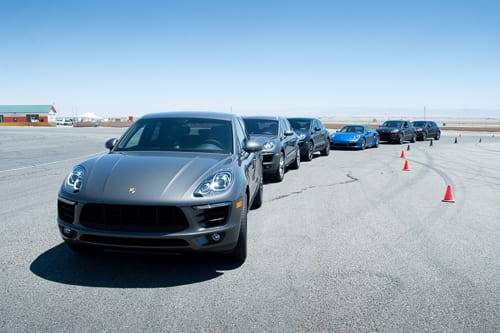
I spent a day driving Porsche’s all-new 2015 Macan luxury compact SUV throughout Southern California, up and down the mountain roads of the Angeles Crest Highway and at Willow Springs International Raceway in the high Southern California desert. All in all, the variety of terrain offered plenty of opportunity for the Macan to show off, or to fall short.
Related: 2015 Porsche Macan Photo Gallery (25 Photos)
The Macan Turbo I drove on the way out to Willow Springs had pretty much every box checked: Porsche Active Suspension Management with air suspension ($1,385), Porsche Torque Vectoring Plus ($1,490), underbody skid plates ($1,410), adaptive cruise control with Porsche Active Safe ($1,600), Burmester High-End Surround Sound System ($4,290) and the Premium Package Plus with a host of safety and luxury features ($4,660) just to name a few. The Macan Turbo has a starting price of $72,295 (including destination), but with all of these options the price tag inched into “holy cow” territory: $101,325.
On the road the Macan is docile, especially in Normal driving mode. The suspension management system puts the adaptive shock absorbers into a more pliant setting, and the steering was lighter than I would have preferred but was still very accurate and managed to avoid the overboosted, floaty feeling found in less refined electric power steering systems. Moving the Macan into Sport or Sport Plus sharpens the SUV, especially the transmission, which delightfully holds onto lower gears. But it’s still a tamer experience than I had envisioned given Porsche’s claims.
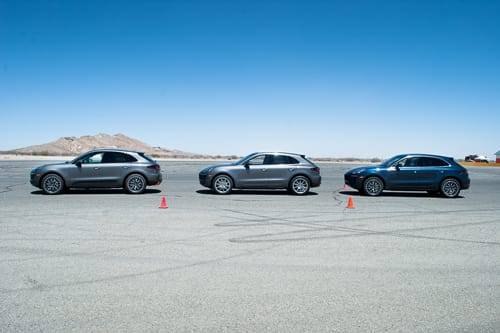
Get the Macan on the track, however, and it’s a different story: A car that feels somewhat bored on the road begins to come alive when pushed. At Willow Springs our first driving session was a handling course, where we drove three Macan S models with different suspension setups: steel springs and regular shocks, PASM (steel springs with adaptive shocks) and PASM with air suspension (air springs with adaptive shocks) in rapid succession to see how each system handled changes in elevation and quick directional inputs. The difference between models with the steel spring suspension and those with PASM was dramatic. With the simpler suspension, all of the Macan’s 4,100-plus pounds were noticeable. The SUV pitched and rolled under braking and hard turns, with any quick directional change testing the seat bolsters (which are excellent, it should be noted).
A Macan with PASM was a completely different story. On the previous run with the steel suspension beneath me, I made a mistake and carried too much speed into one of the hairpins and the Macan started to teeter over and unbalance just like you’d expect in a top-heavy SUV. On the next run, I took the same corner with the same speed but this time with PASM. The Macan stayed flat, plowing through the corner and putting all of its 340 horsepower down on exit.
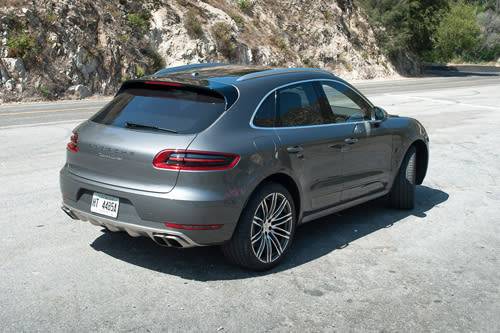
Next up were some lead-follow hot laps around the famed “Streets of Willow Springs” race course, with several of us in Macans chasing after a Cayman S or a 911 Turbo S driven by Porsche driving instructors. Here, the Macan’s new twin-turbocharged engines shined on the track’s longer segments. Both engines, a 340-hp V-6 in the Macan S or a 400-hp V-6 in the Macan Turbo, were more than willing partners, quickly revving up with nary a hint of turbo lag. Porsche’s dual-clutch automatic transmission, PDK, is outstanding per usual; Porsche’s test drivers said the PDK is two seconds faster around their home track than vehicles with a manual transmission, and after pushing its capabilities, I believe it.
(One quick note – were it my dollars on the line, I’d take the Macan S and save the money. You can always add PASM as an option. The difference in acceleration was noticeable, but not great enough to offset the price chasm.)
The Macan Turbo is the most track-capable SUV I’ve ever driven, by a wide margin. But sitting directly behind two lightweight sports cars, watching them flick in and out of corners, issued a stark reminder that I was not in a sports car, but an SUV. It’s akin to watching a prima ballerina at the Bolshoi Theatre do a pirouette and an NFL offensive lineman doing the same move right behind her. Even if they’re both doing the same moves, only one of them is at home on the stage.
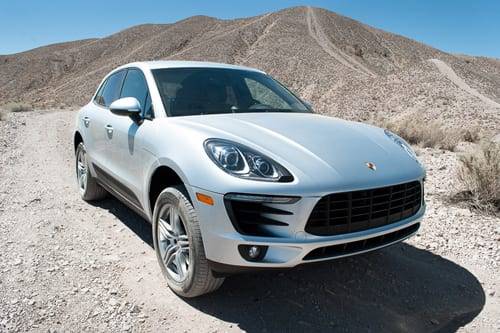
The off-road experience was also impressive. An Off-Road mode comes standard on all Macans; when activated it alters the throttle/transmission mapping, and in models equipped with the optional air suspension, it raises the Macan almost an additional 1.6 inches, bringing total ground clearance to nearly 9.1 inches. PASM also changes the shocks to their stiffest setting, which Porsche reps say will maximize ground clearance since they don’t see owners using the Macan for serious off-roading where a very compliant suspension is required.
The Macan handled the loose rocks and dirt with ease, shifting torque to the wheel(s) with traction (all the torque can be directed to one wheel if needed) and easily cresting the steep grades. On the way down, the hill control system automatically controls the Macan’s descent at a speed indicated by a small icon in the instrument panel.
Taken simply as a piece of engineering the Macan amazes; even seemingly simple pieces like the clamshell hood have purpose (there are air ducts on its underside that route air to the thirsty turbochargers). To get a car with that much weight and height to drive on a track with any sort of competence is impressive, and our hats are off to Porsche.
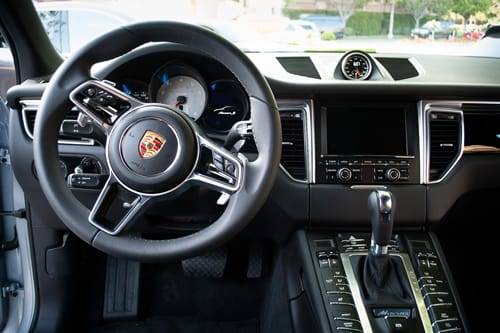
But then there’s the matter of price. Porsche lists the Macan’s competitors as the Mercedes-Benz GLK-Class, BMW X3 and Land Rover’s Range Rover Evoque. I’m confident that none of them can match the Macan on the track or on the road, but the truth remains that they start at around $10,000 less than the Macan and none of them option up to anywhere near six figures.
Even looking at Porsche’s own lineup, the Macan S starts at $50,895 (including destination); that’s slightly more than the base version of the larger Cayenne, which starts at $50,595 with destination and is the more logical choice for families with its larger backseat and added cargo room.
At the end of the day, my feelings about the Macan can be summed up in one word: compromise. It is a thoroughly impressive machine, but it left me wanting. The limited rear seat and cargo room means it’s not ideal for families, and the lack of a true, sporty driving experience means it’s not ideal for a midlife crisis either. And for $101,325, that’s simply not enough.
Cars.com photos by Brian Wong

Former L.A. Bureau Chief Brian Wong is a California native with a soft spot for convertibles and free parking.
Featured stories




